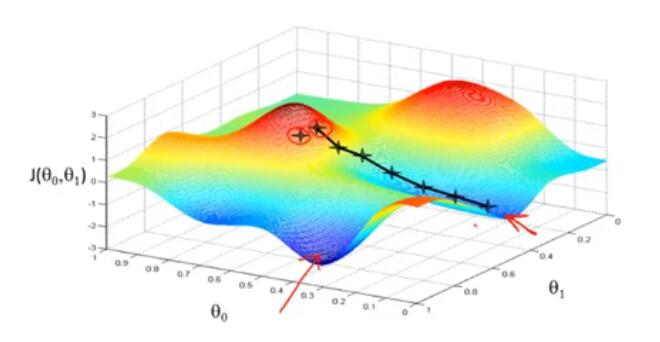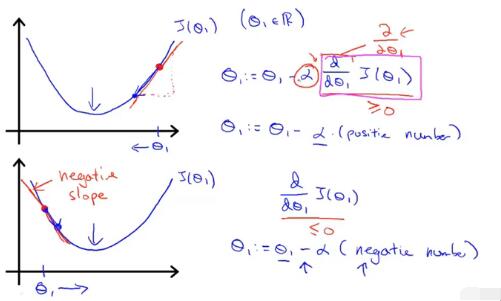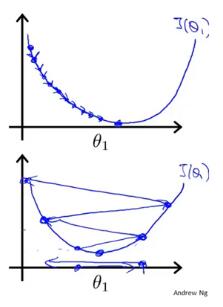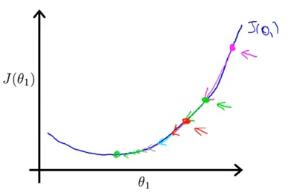chapter 6 Model representation
liner regression. this chapter see what the model looks like and what the overall process of supervised learning looks likes.
supervised learning ,has a data set ,called training set.
m =Number of traning examples
x’s = “input” variable/features
y’s =”output” variable/”target” variable
(x,y) - a single training example
(xi,yi) - ith training example
h - hypothesis
Housing price prediction model called linear regression, linear regression with one variable(univariate linear regression )
chapter 7 Cost function
-Housing price prediction
hypothesis:hθ=θ0+θ1xhθ=θ0+θ1x
θiθi’s:Parameter
choose θ0θ0,θ1θ1 so that hθ(x)hθ(x) is close to y for our training examples (x,y)
Goal: minmize(θ0,θ1)J(θ0,θ1)minmize(θ0,θ1)J(θ0,θ1),
J(θ0,θ1)J(θ0,θ1)is Cost function or Squate error cost function
chapter 8 Cost function intuition 1
give some example to get back to intuition about what the cost function is doing and why we use it .
look up some plots to understand the cost function ,to do so ,we simplify the algorithm,so that it only had one parameter theta one.
chapter 10 Gradient descent
it is taking about gradient descent for minimizing some arbitrary function J.
Have some function J(θ0,θ1)J(θ0,θ1)
Want minθ0,θ1J(θ0,θ1)minθ0,θ1J(θ0,θ1)
Outline:
- start with some θ0,θ1θ0,θ1.
- keep changing θ0,θ1θ0,θ1 to reduce J(θ0,θ1)J(θ0,θ1) until we hopefully end up to a minimum.

Gradient descent algorithm:
repeat until convergence {
θj:=θj−a∂∂θjJ(θ0,θ1)θj:=θj−a∂∂θjJ(θ0,θ1) (for j=0 and j=1)
}
a- called the learning rate,it basically controls how big a step we take downhill with gradient descent.
∂∂θj∂∂θj - it is a derivative term
simultaneously update :
temp0:=θ0−a∂∂θ0J(θ0,θ1)temp0:=θ0−a∂∂θ0J(θ0,θ1)
temp1:=θ1−a∂∂θ1J(θ0,θ1)temp1:=θ1−a∂∂θ1J(θ0,θ1)
θ0:=temp0θ0:=temp0
θ1:=temp1θ1:=temp1
in the next chapter ,we’re going to go into the details of the derivative term.which it wrote out but didn’t really define.
chapter 11 Gradient descent intuition
get better intuition about what the algorithm is doing ,and why the steps of the gradient descent algorithm might make sense.


if aa is too small,gradient descent can be slow.
if is too large,gradient descent can overshoot the minimum.it may fail to converge or even diverge.

if you’re already at a local optimum,one step of gradient descent does absolutely nothing.It doesn’t change parameter.cause it keeps your solution at the local optimum.
Gradient descent can converge to a local minimum,even with the learning rate aa fixed.
As we approach a local minimum.gradient descent will automatically take smaller steps.So,no need to decrease aa over time.

derivative term and partial derivative
chapter 12 Gradient descent for linear regression
put together gradient descent with our cost function,and that will give us an algorithm for linear regression for fitting a straight line to our data.
Gradient descent algorithm :
the key term we need is this derivative term over here.
j=0:∂∂θ0J(θ0,θ1)=1m∑mi=1(θ0+θ1x(i)+y(i))⋅(θ0+θ1x(i)+y(i))′=1m∑mi=1(θ0+θ1x(i)+y(i))j=0:∂∂θ0J(θ0,θ1)=1m∑i=1m(θ0+θ1x(i)+y(i))·(θ0+θ1x(i)+y(i))′=1m∑i=1m(θ0+θ1x(i)+y(i))
j=0:∂∂θ1J(θ0,θ1)=1m∑mi=1(θ0+θ1x(i)+y(i))⋅(θ0+θ1x(i)+y(i))′=1m∑mi=1(θ0+θ1x(i)+y(i))⋅x(i)j=0:∂∂θ1J(θ0,θ1)=1m∑i=1m(θ0+θ1x(i)+y(i))·(θ0+θ1x(i)+y(i))′=1m∑i=1m(θ0+θ1x(i)+y(i))·x(i)

“Batch” Gradient Descent :
“Batch”: Each step of gradient descent uses all the training examples.








 本文介绍线性回归的基本概念及其在房价预测中的应用,并深入探讨了梯度下降算法的工作原理,包括如何通过成本函数来调整参数以实现模型优化。
本文介绍线性回归的基本概念及其在房价预测中的应用,并深入探讨了梯度下降算法的工作原理,包括如何通过成本函数来调整参数以实现模型优化。
















 638
638

 被折叠的 条评论
为什么被折叠?
被折叠的 条评论
为什么被折叠?








